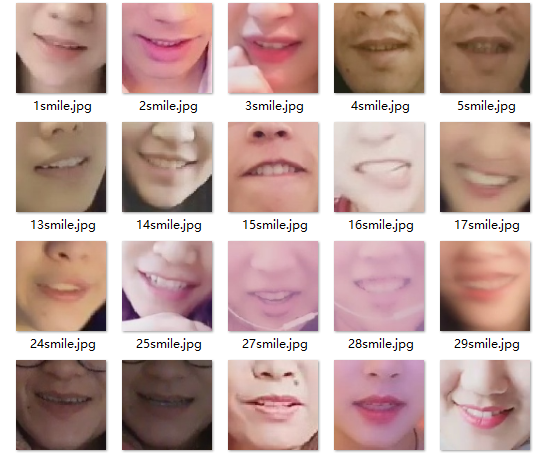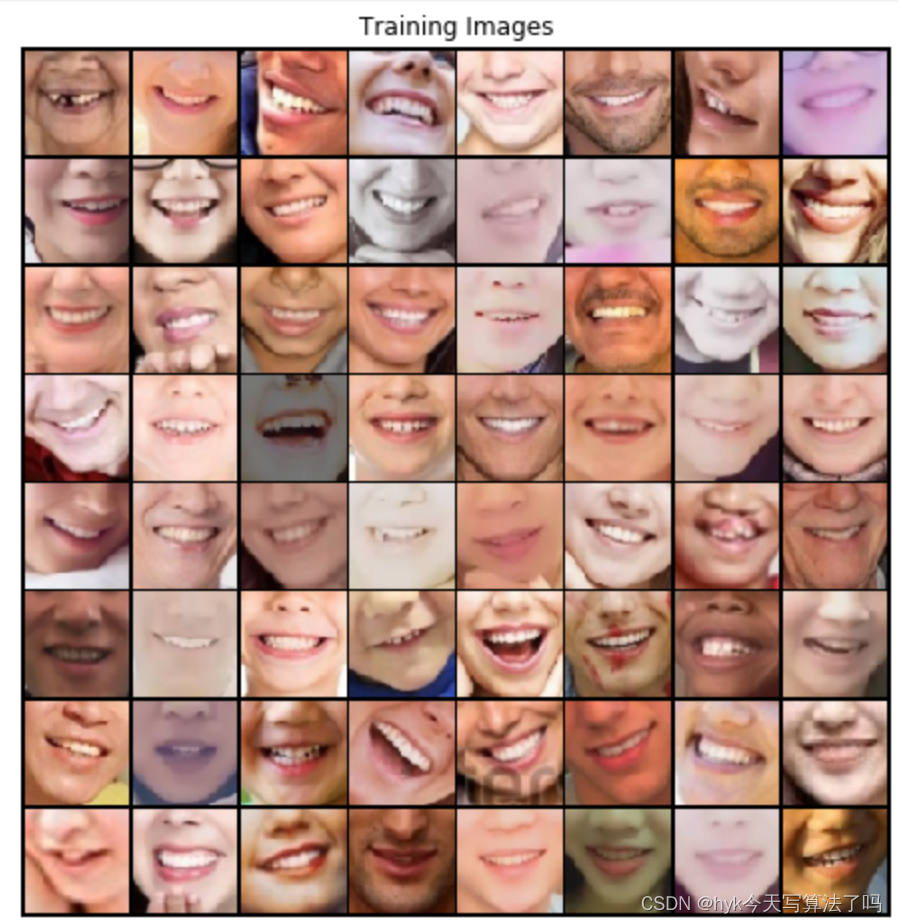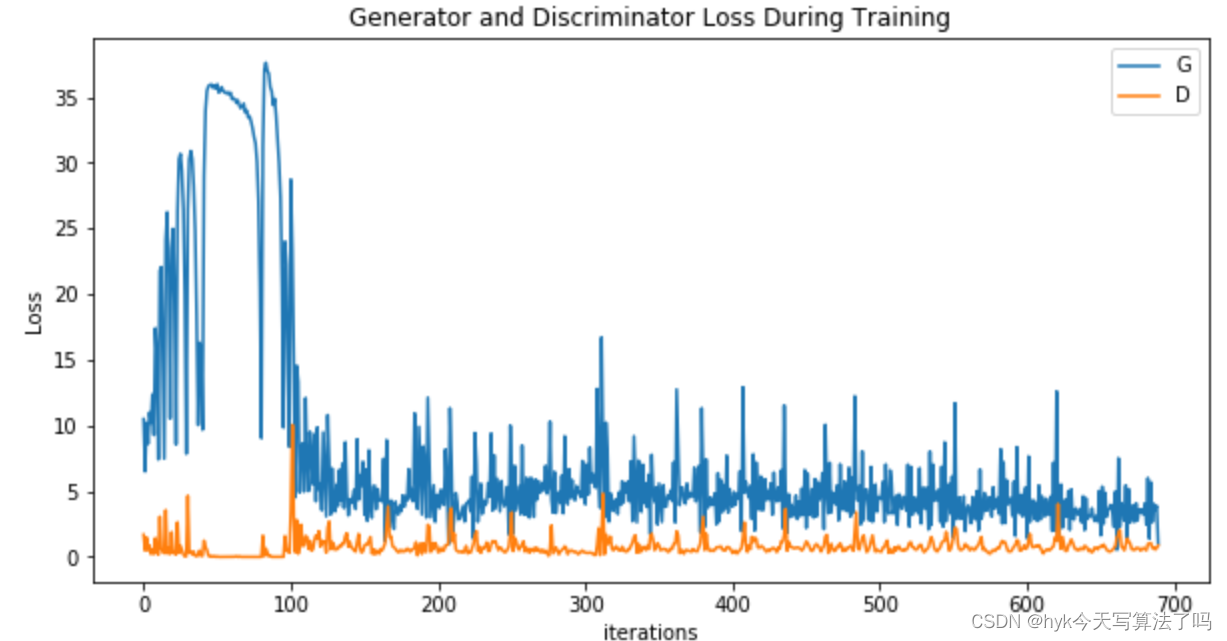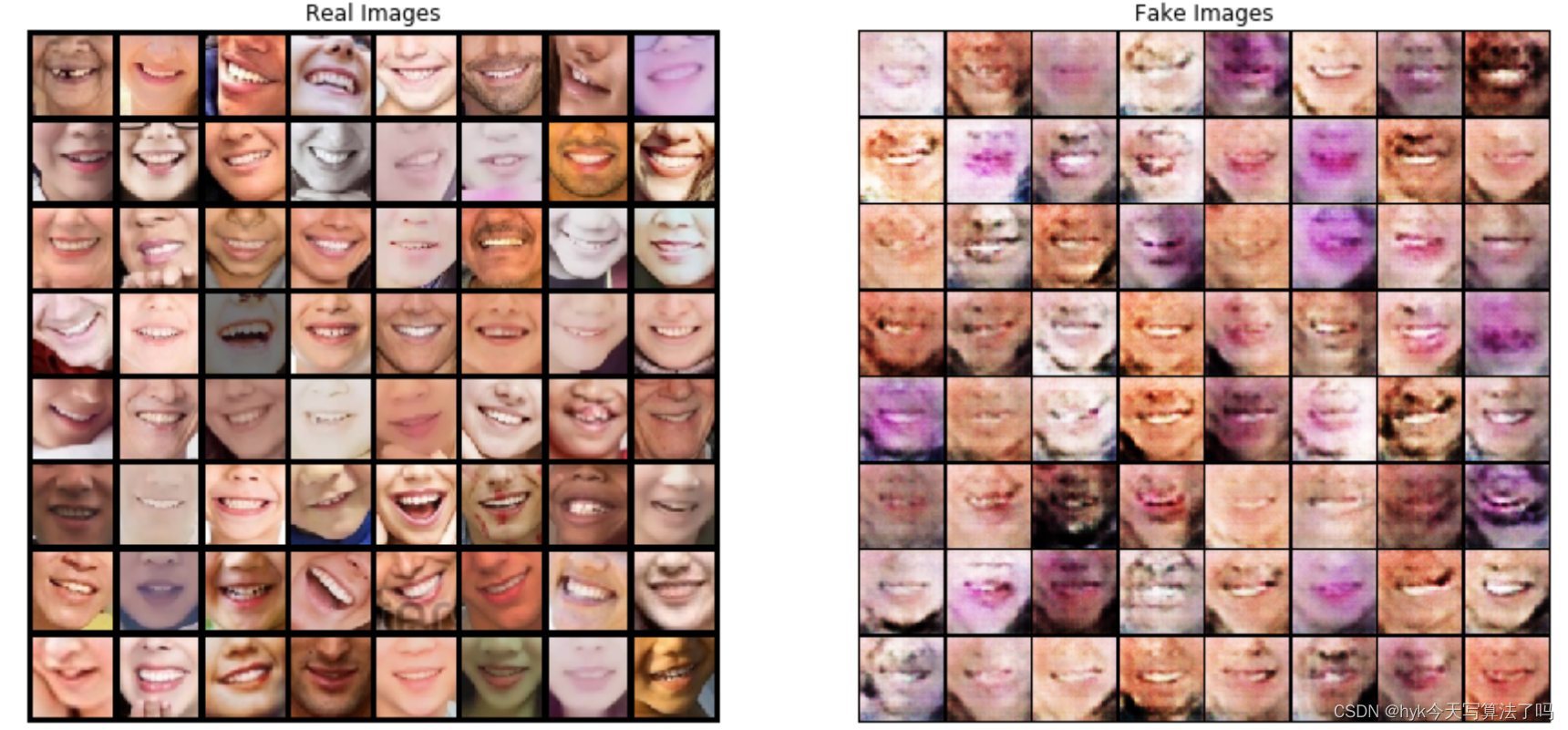目录
前言导入所需包基本参数配置导入数据集定义生成器与判别器初始化生成器和判别器定义损失函数开始训练绘制损失曲线真假对比
前言
本项目使用 DCGAN 模型,在自建数据集上进行实验。
本项目使用的数据集是人脸嘴巴区域——微笑表情的数据集

数据集文件夹结构如下,图片供 4357 张
├─mouth│ └─smile ├─1smile.jpg ├─2smile.jpg ├─3smile.jpg └─.... 同时,创建一个 out 文件夹来保存训练的中间结果,主要就是看 DCGAN 是如何从一张噪声照片生成我们期待的图片
import osimport timeif os.path.exists("out"): print("移除现有 out 文件夹!") os.system("rm -r ./out")time.sleep(1)print("创建 out 文件夹!")os.mkdir("./out")移除现有 out 文件夹!
创建 out 文件夹!
下方链接为该数据集压缩包,需要者自取:数据集
运行下面代码,对数据集进行解压。
由于图片数量多,解压需要一定时间
!unzip mouth.zip -d ./mouthprint("解压完毕!")导入所需包
from __future__ import print_function#%matplotlib inlineimport argparseimport osimport randomimport torchimport torch.nn as nnimport torch.nn.parallelimport torch.backends.cudnn as cudnnimport torch.optim as optimimport torch.utils.dataimport torchvision.datasets as dsetimport torchvision.transforms as transformsimport torchvision.utils as vutilsimport numpy as npimport matplotlib.pyplot as pltimport matplotlib.animation as animationfrom IPython.display import HTMLos.environ['KMP_DUPLICATE_LIB_OK'] = 'True'基本参数配置
# 设置一个随机种子,方便进行可重复性实验manualSeed = 999print("Random Seed: ", manualSeed)random.seed(manualSeed)torch.manual_seed(manualSeed)# 数据集所在路径dataroot = "mouth/"# 数据加载的进程数workers = 0# Batch size 大小batch_size = 64# Spatial size of training images. All images will be resized to this# size using a transformer.# 图片大小image_size = 64# 图片的通道数nc = 3# Size of z latent vector (i.e. size of generator input)nz = 100# Size of feature maps in generatorngf = 64# Size of feature maps in discriminatorndf = 64# Number of training epochsnum_epochs = 10# Learning rate for optimizerslr = 0.0003# Beta1 hyperparam for Adam optimizersbeta1 = 0.5# Number of GPUs available. Use 0 for CPU mode.ngpu = 1# Decide which device we want to run ondevice = torch.device("cuda:0" if (torch.cuda.is_available() and ngpu > 0) else "cpu")导入数据集
# We can use an image folder dataset the way we have it setup.# Create the datasetdataset = dset.ImageFolder(root=dataroot, transform=transforms.Compose([ transforms.Resize(image_size), transforms.CenterCrop(image_size), transforms.ToTensor(), transforms.Normalize((0.5, 0.5, 0.5), (0.5, 0.5, 0.5)), ]))# Create the dataloaderdataloader = torch.utils.data.DataLoader(dataset, batch_size=batch_size, shuffle=True, num_workers=workers)简单看一下我们的原始数据集长啥样
# Plot some training imagesreal_batch = next(iter(dataloader))plt.figure(figsize=(8,8))plt.axis("off")plt.title("Training Images")plt.imshow(np.transpose(vutils.make_grid(real_batch[0].to(device)[:64], padding=2, normalize=True).cpu(),(1,2,0)))# plt.show()<matplotlib.image.AxesImage at 0x7f67b59d9cf8>
定义生成器与判别器
# 权重初始化函数,为生成器和判别器模型初始化def weights_init(m): classname = m.__class__.__name__ if classname.find('Conv') != -1: nn.init.normal_(m.weight.data, 0.0, 0.02) elif classname.find('BatchNorm') != -1: nn.init.normal_(m.weight.data, 1.0, 0.02) nn.init.constant_(m.bias.data, 0)# Generator Codeclass Generator(nn.Module): def __init__(self, ngpu): super(Generator, self).__init__() self.ngpu = ngpu self.main = nn.Sequential( # input is Z, going into a convolution nn.ConvTranspose2d( nz, ngf * 8, 4, 1, 0, bias=False), nn.BatchNorm2d(ngf * 8), nn.ReLU(True), # state size. (ngf*8) x 4 x 4 nn.ConvTranspose2d(ngf * 8, ngf * 4, 4, 2, 1, bias=False), nn.BatchNorm2d(ngf * 4), nn.ReLU(True), # state size. (ngf*4) x 8 x 8 nn.ConvTranspose2d( ngf * 4, ngf * 2, 4, 2, 1, bias=False), nn.BatchNorm2d(ngf * 2), nn.ReLU(True), # state size. (ngf*2) x 16 x 16 nn.ConvTranspose2d( ngf * 2, ngf, 4, 2, 1, bias=False), nn.BatchNorm2d(ngf), nn.ReLU(True), # state size. (ngf) x 32 x 32 nn.ConvTranspose2d( ngf, nc, 4, 2, 1, bias=False), nn.Tanh() # state size. (nc) x 64 x 64 ) def forward(self, input): return self.main(input)class Discriminator(nn.Module): def __init__(self, ngpu): super(Discriminator, self).__init__() self.ngpu = ngpu self.main = nn.Sequential( # input is (nc) x 64 x 64 nn.Conv2d(nc, ndf, 4, 2, 1, bias=False), nn.LeakyReLU(0.2, inplace=True), # state size. (ndf) x 32 x 32 nn.Conv2d(ndf, ndf * 2, 4, 2, 1, bias=False), nn.BatchNorm2d(ndf * 2), nn.LeakyReLU(0.2, inplace=True), # state size. (ndf*2) x 16 x 16 nn.Conv2d(ndf * 2, ndf * 4, 4, 2, 1, bias=False), nn.BatchNorm2d(ndf * 4), nn.LeakyReLU(0.2, inplace=True), # state size. (ndf*4) x 8 x 8 nn.Conv2d(ndf * 4, ndf * 8, 4, 2, 1, bias=False), nn.BatchNorm2d(ndf * 8), nn.LeakyReLU(0.2, inplace=True), # state size. (ndf*8) x 4 x 4 nn.Conv2d(ndf * 8, 1, 4, 1, 0, bias=False), nn.Sigmoid() ) def forward(self, input): return self.main(input)初始化生成器和判别器
# Create the generatornetG = Generator(ngpu).to(device)# Handle multi-gpu if desiredif (device.type == 'cuda') and (ngpu > 1): netG = nn.DataParallel(netG, list(range(ngpu)))# Apply the weights_init function to randomly initialize all weights# to mean=0, stdev=0.2.netG.apply(weights_init)# Print the modelprint(netG)# Create the DiscriminatornetD = Discriminator(ngpu).to(device)# Handle multi-gpu if desiredif (device.type == 'cuda') and (ngpu > 1): netD = nn.DataParallel(netD, list(range(ngpu)))# Apply the weights_init function to randomly initialize all weights# to mean=0, stdev=0.2.netD.apply(weights_init)# Print the modelprint(netD)定义损失函数
# Initialize BCELoss functioncriterion = nn.BCELoss()开始训练
# Create batch of latent vectors that we will use to visualize# the progression of the generatorfixed_noise = torch.randn(64, nz, 1, 1, device=device)# Establish convention for real and fake labels during trainingreal_label = 1.0fake_label = 0.0# Setup Adam optimizers for both G and DoptimizerD = optim.Adam(netD.parameters(), lr=lr, betas=(beta1, 0.999))optimizerG = optim.Adam(netG.parameters(), lr=lr, betas=(beta1, 0.999))# Training Loop# Lists to keep track of progressimg_list = []G_losses = []D_losses = []iters = 0print("Starting Training Loop...")# For each epochfor epoch in range(num_epochs): import time start = time.time() # For each batch in the dataloader for i, data in enumerate(dataloader, 0): ############################ # (1) Update D network: maximize log(D(x)) + log(1 - D(G(z))) ########################### ## Train with all-real batch netD.zero_grad() # Format batch real_cpu = data[0].to(device) b_size = real_cpu.size(0) label = torch.full((b_size,), real_label, device=device) # Forward pass real batch through D output = netD(real_cpu).view(-1) # Calculate loss on all-real batch errD_real = criterion(output, label) # Calculate gradients for D in backward pass errD_real.backward() D_x = output.mean().item() ## Train with all-fake batch # Generate batch of latent vectors noise = torch.randn(b_size, nz, 1, 1, device=device) # Generate fake image batch with G fake = netG(noise) label.fill_(fake_label) # Classify all fake batch with D output = netD(fake.detach()).view(-1) # Calculate D's loss on the all-fake batch errD_fake = criterion(output, label) # Calculate the gradients for this batch errD_fake.backward() D_G_z1 = output.mean().item() # Add the gradients from the all-real and all-fake batches errD = errD_real + errD_fake # Update D optimizerD.step() ############################ # (2) Update G network: maximize log(D(G(z))) ########################### netG.zero_grad() label.fill_(real_label) # fake labels are real for generator cost # Since we just updated D, perform another forward pass of all-fake batch through D output = netD(fake).view(-1) # Calculate G's loss based on this output errG = criterion(output, label) # Calculate gradients for G errG.backward() D_G_z2 = output.mean().item() # Update G optimizerG.step() # Output training stats if i % 50 == 0: print('[%d/%d][%d/%d]\tLoss_D: %.4f\tLoss_G: %.4f\tD(x): %.4f\tD(G(z)): %.4f / %.4f' % (epoch, num_epochs, i, len(dataloader), errD.item(), errG.item(), D_x, D_G_z1, D_G_z2)) # Save Losses for plotting later G_losses.append(errG.item()) D_losses.append(errD.item()) # Check how the generator is doing by saving G's output on fixed_noise if (iters % 20 == 0) or ((epoch == num_epochs-1) and (i == len(dataloader)-1)): with torch.no_grad(): fake = netG(fixed_noise).detach().cpu() img_list.append(vutils.make_grid(fake, padding=2, normalize=True)) i = vutils.make_grid(fake, padding=2, normalize=True) fig = plt.figure(figsize=(8, 8)) plt.imshow(np.transpose(i, (1, 2, 0))) plt.axis('off') # 关闭坐标轴 plt.savefig("out/%d_%d.png" % (epoch, iters)) plt.close(fig) iters += 1 print('time:', time.time() - start)绘制损失曲线
plt.figure(figsize=(10,5))plt.title("Generator and Discriminator Loss During Training")plt.plot(G_losses,label="G")plt.plot(D_losses,label="D")plt.xlabel("iterations")plt.ylabel("Loss")plt.legend()plt.show()
真假对比
# Grab a batch of real images from the dataloader# real_batch = next(iter(dataloader))# Plot the real imagesplt.figure(figsize=(15,15))plt.subplot(1,2,1)plt.axis("off")plt.title("Real Images")plt.imshow(np.transpose(vutils.make_grid(real_batch[0].to(device)[:64], padding=5, normalize=True).cpu(),(1,2,0)))# Plot the fake images from the last epochplt.subplot(1,2,2)plt.axis("off")plt.title("Fake Images")plt.imshow(np.transpose(img_list[-1],(1,2,0)))plt.show()